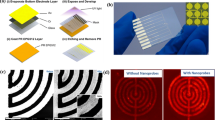Abstract
In vitro diagnostic technologies, used to evaluate disease status at the point-of-care (POC), are of urgent importance to improve diagnostic capabilities in bladder cancer. However, currently available approaches have a limitation because of their lack of detection for early-staged cancer. Herein, we developed an electrochemical immunosensor for the POC diagnosis of bladder cancer in which the enzyme alkaline phosphatase (ALP) and its metabolite, ascorbic acid 2-phosphate (AAP), are employed as the electrochemical label and redox signaling unit. The indium tin oxide (ITO) electrode exhibits no redox activity toward the AAP substrate, whereas its metabolic add of ascorbic acid (AA) produces strong oxidation current under the voltammetric measurement. The ITO electrode and the ALP enzyme are revealed as an excellent combination for the development of the electrochemical immunosensors in both direct- and sandwich-type immunoassay approach. Determination of apolipoprotein-A4 and metallopeptidase-9, two representative bladder cancer markers, were used to evaluate our approach, and excellent quantification with standard deviation 10 % was achieved. Overall, our results showed that our method offers an opportunity for the development of a variety of new forms of portable POC diagnostic devices with low cost and excellent performance.






Similar content being viewed by others
References
U. Pillai, R. & Cherian, S. Emerging Technologies for Point-of-Care Testing: A future outlook for Scientists and Engineers. Review article.
P. & Patel, J. Biosensors and biomarkers: promising tools for cancer diagnosis. Int. J. Biosen. Bioelectron.3, 313–316 (2017).
Yager, P., Domingo, G.J., & Gerdes, J. Point-of-care diagnostics for global health. Annu. Rev. Biomed. Eng.10, 107–144 (2008).
Rusling, J.F., Kumar, C.V., Gutkind, J.S. & Patel, V. Measurement of biomarker proteins for point-of-care early detection and monitoring of cancer. Analyst135, 2496–2511 (2010).
Kim, H., Chung, D.R. & Kang, M. A new point-of-care test for the diagnosis of infectious diseases based on multiplex lateral flow immunoassays. Analyst144, 2460–2466 (2019).
S.K. Point-of-care diagnostics: Recent advances and trends. Biosensors7, 62 (2017).
Crook, N.E., & Payne, C.C. Comparison of three methods of ELISA for baculoviruses. J. Gen. Virol.46, 29–37 (1980).
Glavan, A.C., Christodouleas, D.C., Mosadegh, B., Yu, H.D., Smith, B.S., Lessing, J., Fernández-Abedul, M.T. & Whitesides, G.M. Folding analytical devices for electrochemical ELISA in hydrophobic RH paper. Anal. Chem.86, 11999–12007 (2014).
Klein-Schneegans, A.S., Gavériaux, C., Fonteneau, P. & Loor, F. Indirect double sandwich ELISA for the specific and quantitative measurement of mouse IgM, IgA and IgG subclasses. J. Immunol. Methods119, 117–125 (1989).
Kim, S.-E., Kim, Y.J., Song, S., Lee, K.-N. & Seong, W.K. A simple electrochemical immunosensor platform for detection of apolipoprotein A1 (Apo-A1) as a bladder cancer biomarker in urine. Sens. Actuators, B278, 103–109 (2019).
Gan, S.D. & Patel, K.R. Enzyme immunoassay and enzyme-linked immunosorbent assay. J. Invest. Dermatol.133, 1–3 (2013).
Li, C., Yang, Y., Wu, D., Li, T., Yin, Y. & Li, G. Improvement of enzyme-linked immunosorbent assay for the multicolor detection of biomarkers. Chem. Sci.7, 3011–3016 (2016).
Wang, L., Du, D., Lu, D., Lin, C.T., Smith, J.N., Timchalk, C., Liu, F., Wang, J. & Lin, Y. Enzyme-linked immunosorbent assay for detection of organophosphorylated butyrylcholinesterase: a biomarker of exposure to organophosphate agents. Anal. Chim. Acta693, 1–6 (2011).
Nimse, S.B., Sonawane, M.D., Song, K.S. & Kim, T. Biomarker detection technologies and future directions. Analyst141, 740–755 (2016).
Hutchinson, L.M., Chang, E.L., Becker, C.M., Ushiyama, N., Behonick, D., Shih, M.C., De Wolf, W.C., Gaston, S.M. & Zetter, B.R. Development of a sensitive and specific enzyme-linked immunosorbent assay for thymosin β15, a urinary biomarker of human prostate cancer. Clin. Biochem.38, 558–571 (2005).
Kwon, S.J., Yang, H., Jo, K. & Kwak, J. An electrochemical immunosensor using p-aminophenol redox cycling by NADH on a self-assembled monolayer and ferrocene-modified Au electrodes. Analyst133, 1599–1604 (2008).
Akanda, M.R., Aziz, M.A., Jo, K., Tamilavan, V., Hyun, M.H., Kim, S. & Yang, H. Optimization of phosphatase-and redox cycling-based immunosensors and its application to ultrasensitive detection of troponin I. Anal. Chem.83, 3926–3933 (2011).
Choi, M., Jo, K. & Yang, H. Effect of different pre-treatments on indium-tin oxide electrodes. Bull. Korean Chem. Soc.34, 421–425 (2013).
Seong, W.K., Song, S., Kim, Y.J. & Lee, K.N. Detection method of a electrochemical biosensor for a bladder cancer biomarker in urine. Polymer Science and Technology30, 228–231 (2019).
Karathanasis, S.K., Oettgen, P., Haddad, I.A. & Antonarakis, S.E. Structure, evolution, and polymorphisms of the human apolipoprotein A4 gene (APOA4). Proc. Natl. Acad. Sci. U. S. A.83, 8457–8461 (1986).
Jin, J., Min, H., Kim, S.J., Oh, S., Kim, K., Yu, H.G., Park T & Kim Y. Development of diagnostic biomarkers for detecting diabetic retinopathy at early stages using quantitative proteomics. J. Diabetes Res.2016, 6571976 (2016).
Eissa, S., Ali-Labib, R., Swellam, M., Bassiony, M., Tash, F. & El-Zayat, T.M. Noninvasive diagnosis of bladder cancer by detection of matrix metalloproteinases (MMP-2 and MMP-9) and their inhibitor (TIMP-2) in urine. Eur. Urol.52, 1388–1396 (2007).
Ricci, S., Bruzzese, D. & Di Carlo, A. Evaluation of MMP-2, MMP-9, TIMP-1, TIMP-2, NGAL and MMP-9/NGAL complex in urine and sera from patients with bladder cancer. Oncol. Lett.10, 2527–2532 (2015).
Offersen, B.V., Knap, M.M., Horsman, M.R., Verheijen, J., Hanemaaijer, R. & Overgaard, J. Matrix metalloproteinase-9 measured in urine from bladder cancer patients is an independent prognostic marker of poor survival. Acta Oncol.49, 1283–1287 (2010).
Acknowledgements
This work was financially supported by the Bio & Medical Technology Development Program of the National Research Foundation (grant no. NRF-2015M3A9E2028480), and by the research funds (grant no. 10077648) of the Ministry of trade, Industry and Energy, Korea.
Author information
Authors and Affiliations
Corresponding authors
Additional information
Conflict of Interests The authors declare no competing financial interests.
Rights and permissions
About this article
Cite this article
Song, S., Kim, Y.J., Shin, IS. et al. Electrochemical Immunoassay Based on Indium Tin Oxide Activity Toward a Alkaline Phosphatase. BioChip J 13, 387–393 (2019). https://doi.org/10.1007/s13206-019-3410-5
Received:
Accepted:
Published:
Issue Date:
DOI: https://doi.org/10.1007/s13206-019-3410-5




